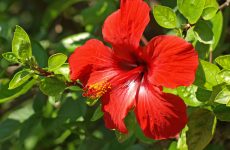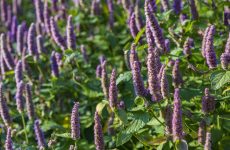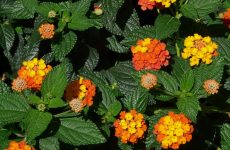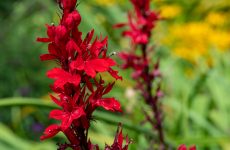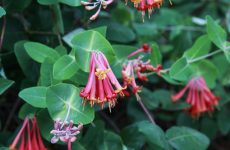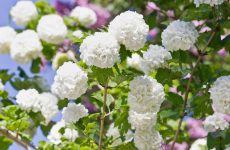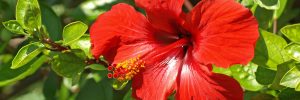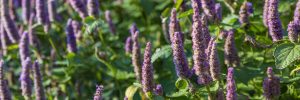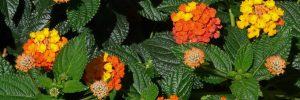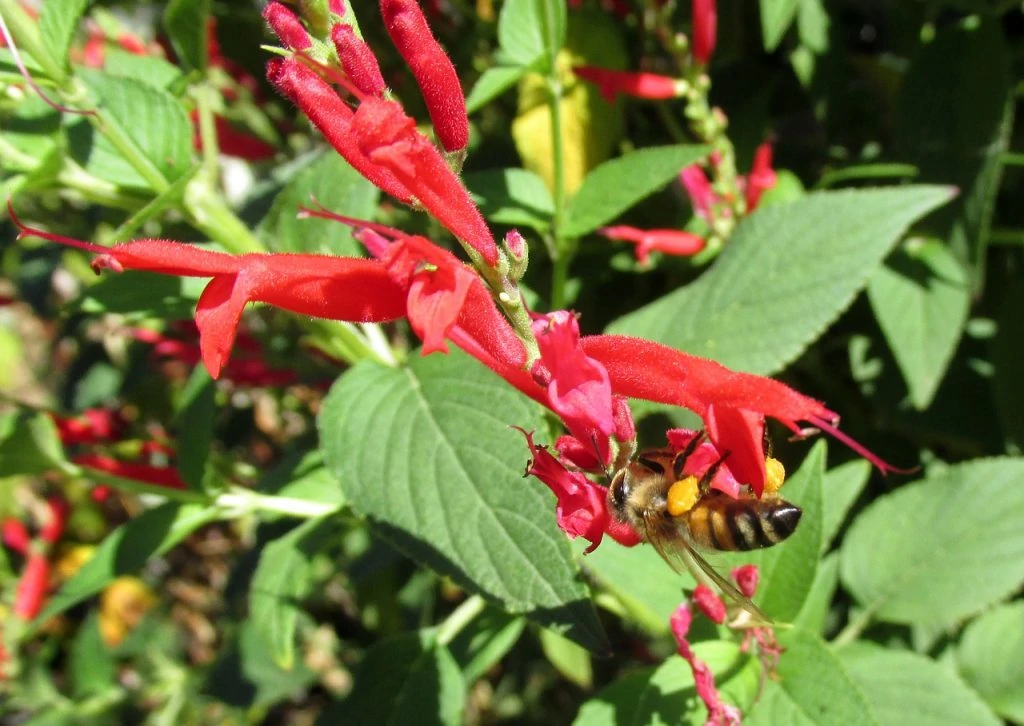
Annuals are a great choice to attract hummingbirds to your yard as they are also a cheap way to add color and impact.
Annuals are plants that die in winter, but their seeds are scattered on the ground, so they regrow from these. You can also buy them as small plants ready to go in the ground. Annuals are great as you can change parts of your yard from year to year.
Hummingbirds like all these annuals as they have the nectar they need to fuel their busy lives. Many annuals require full sun to grow and produce flowers, but there are some on the list that you can grow in partial shade.
So what are you waiting for? Give these annuals a go.
13 Annuals That Attract Hummingbirds:
1. Cape Fuchsia
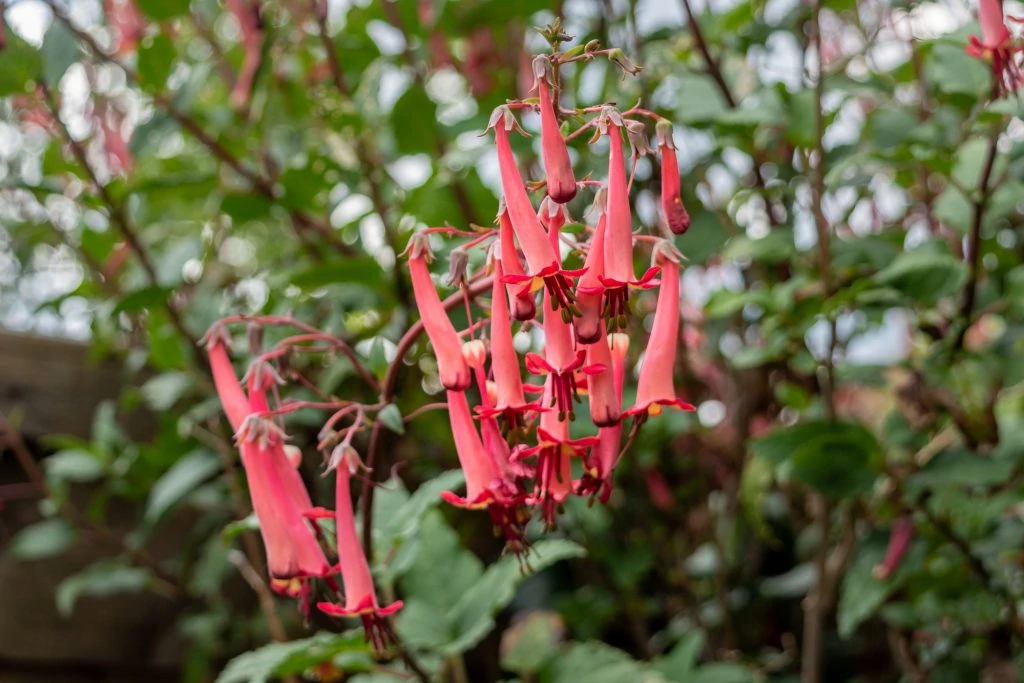
Cape Fuchsia, Latin name Phygelius capensis, is a flowering plant from the family Scrophulariaceae. It is a semi-evergreen shrub that can grow from 3 to 5 feet and is native to South Africa, and its name comes from the Cape of Good Hope.
What makes Cape Fuchsia a good ornamental plant is its long flowering season. From May to November, you can enjoy its brilliant colors, depending on the variety that you have. There are yellow, peach, coral, magenta, and red variants that are 2 inches long, tubular, and hang upright or vertical on stems.
Cape Fuchsia is easy to take care of because it is not picky about the soil you place it in as long as it receives just the right amount of water and a full dose of sunlight. It grows and spreads fast too from its underground stems, so you just need to make sure to constrict it to its space so it won’t overwhelm other shorter plants.
It’s pretty drought-tolerant, but you have to keep the soil moist when the weather becomes too hot. Also, when it’s too hot, it wouldn’t hurt to bring it under partial shade. It flowers for a long time too, which is a really good treat for hummingbirds.
- Common Name: Cape Fuchsia
- Scientific Name: Phygelius capensis
- Growing Zones: 5 – 7
- Sun: Full sun
- Soil: well-drained soil
- Colors: yellow, peach, coral, magenta, red
- Height: 3 – 5 feet
- Spread: 3 – 5 feet
- Plant Type: Perennial, annual
2. Hyacinth Bean
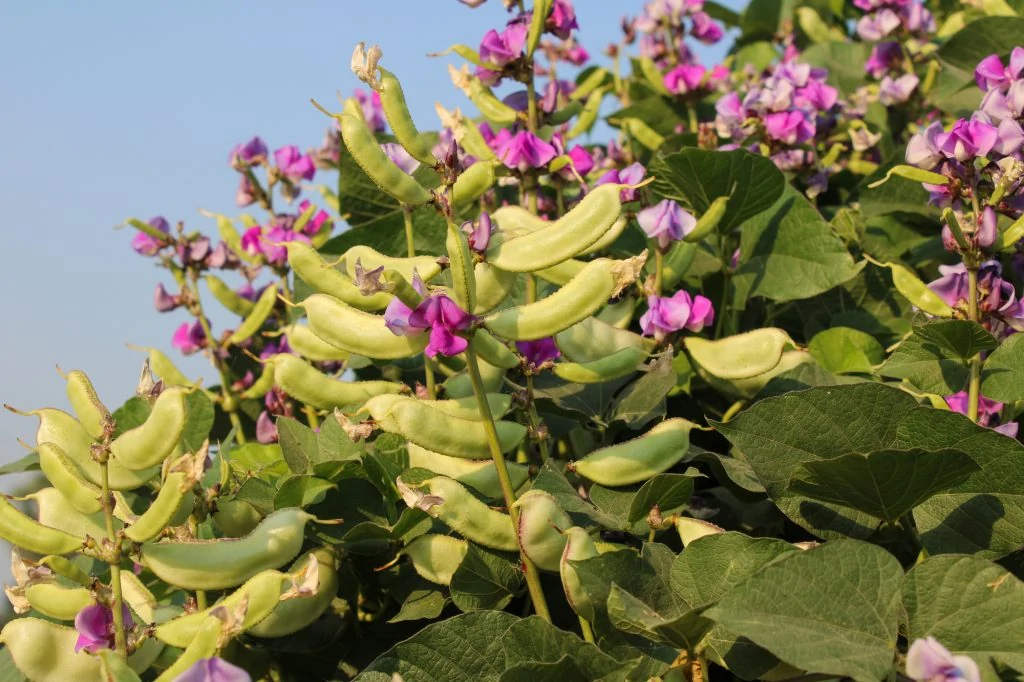
The Hyacinth Bean, or Lablab Purpureus, is a bean vine from the Fabaceae family. It is also known as Indian Bean, Egyptian bean, bataw, and Australian pea because although it is native to Africa, it is cultivated and used for food in Asia.
In the United States, it is commonly used as an ornamental plant because of its pinkish-lavender blossoms and equally captivating purple seed pods. It is also called the Jefferson Bean because Bernard McMahon, Thomas Jefferson’s nurseryman, apparently sold it to him in 1804.
To get the best quality flowers from the Hyacinth Bean, it is best to plant them as seeds in the backyard when the climate is warm in the spring. This will yield more flowers and grow more vines. Hyacinth bean vines can grow as tall as 25 feet when securely anchored to trellises and other types of support.
Flowers begin to bloom in summer through fall. They form clusters along the stalks, and they’re colored white, pink, lavender, or purple. Once the flowers are gone, the seedpods take over, and they’re also as pretty as the flowers. They’re purple, elongated, and have 2 -3 seeds per pod, but these are poisonous and not to be ingested.
Hummingbirds love these purple flowers, and it’s surprisingly easy to take care of. All you need is to give it a full dose of sunlight, just the right type of support to guide the vine on its path and to provide regular watering for young plants before they’re established.
They can be perennial if the weather is mild, but if not, better treat it as an annual and make sure to keep some of the seeds so you can plant them during the next season.
- Common Name: Hyacinth Bean, Indian Bean, Egyptian bean, bataw, Australian pea
- Scientific Name: Lablab Purpureus
- Growing Zones: 4 – 9
- Sun: Full sun (no partial shade)
- Soil: Well-draining soil
- Colors: white, pink, lavender, purple
- Height: 10 – 25 feet
- Spread: 3 – 6 feet
- Plant Type: Annual
3. Salvia
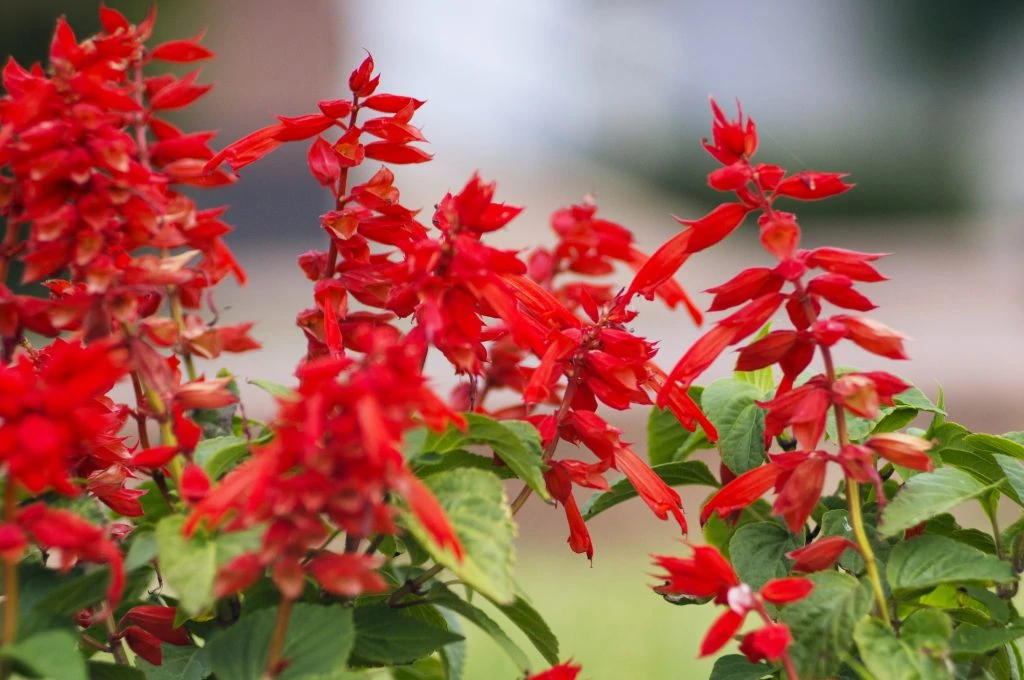
With over 1000 species of these members of the mint family, salvias are a great perennial to choose for hummingbirds. They are also drought-resistant and easy to care for.
Salvias evolved alongside hummingbirds in the Americas, and they use the hummingbirds’ long bills to enter the flower and open a trapdoor that deposits pollen on their heads and rewards them with rich nectar.
They put on a rich display of flowers and tubular blossoms all summer that keep the hummingbirds coming back.
Many native species of salvia are drought tolerant and grow happily in the heat of the South. Although salvias are heat and drought tolerant, if it is very dry, then water thoroughly once a week.
Sometimes known as sage plants, they can be grown as annuals, but also perennial varieties are available. Deadhead them during the summer to encourage more flowers but leave flowers on at the end of the season, so they reseed.
Choose Salvias with red, pink, and orange-colored flowers. Native species are best, but Salvias from Europe are hardier and will grow further north, extending the range and nectar availability for hummingbirds.
- Common Name: salvia
- Scientific Name: salvia
- Growing Zones: 4 – 10
- Sun: Full sun, but some will tolerate partial shade
- Soil: Well-drained
- Colors: Red, pink, purple, blue, white, yellow.
- Height: 1 – 6 feet
- Spread: 1 – 6 feet
- Plant Type: Annual, Perennial
4. Impatiens
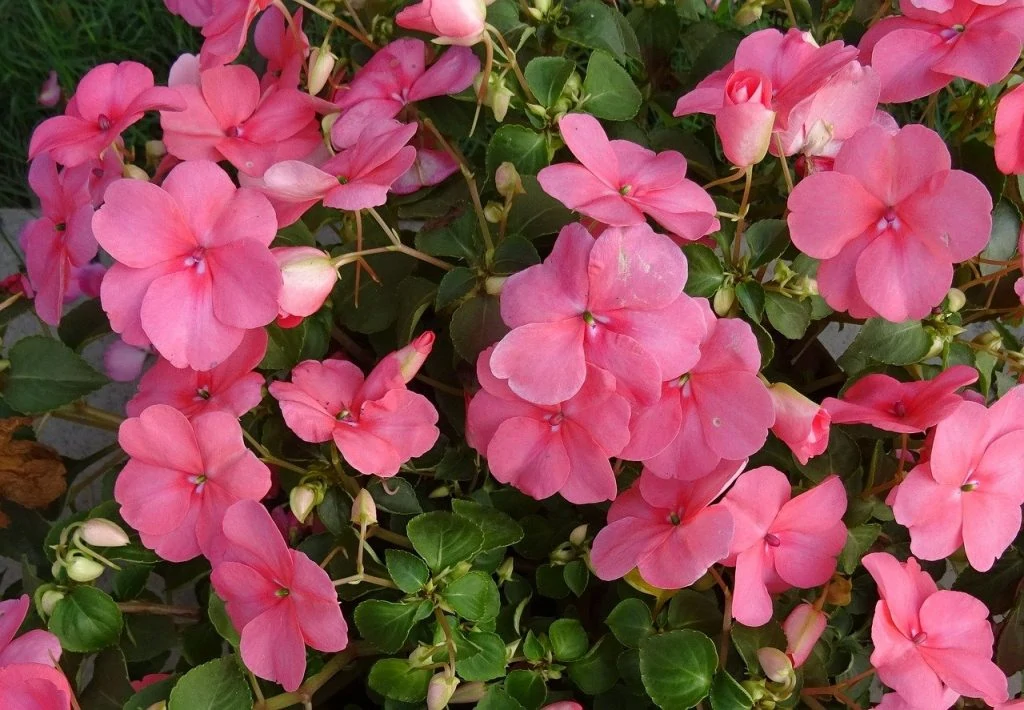
Bright and colorful annuals such as Impatiens are great at brightening up dark and shady areas, and these also attract hummingbirds.
They like moist and well-draining soil and deep shade, so hanging them on your porch will also work well.
Usually grown from plants bought in trays at nurseries and planted close together to create a dense mat of flowers and leaves.
Seeds can be collected from the plants and sown indoors 10 weeks before the last frost as they take a long time to flower. Cuttings can also be taken in the fall and grown indoors until the frost has passed.
- Common Name: impatiens, jewelweed, touch-me-not, snapweed, and patience
- Scientific Name: impatiens
- Growing Zones: 2 – 11
- Sun: Shade or partial shade
- Soil: Rich, well-draining
- Colors: Red, pink, purple, yellow, coral.
- Height: 6 – 36 inches
- Spread: 1 – 3 feet
- Plant Type: Annual
5. Nasturtiums
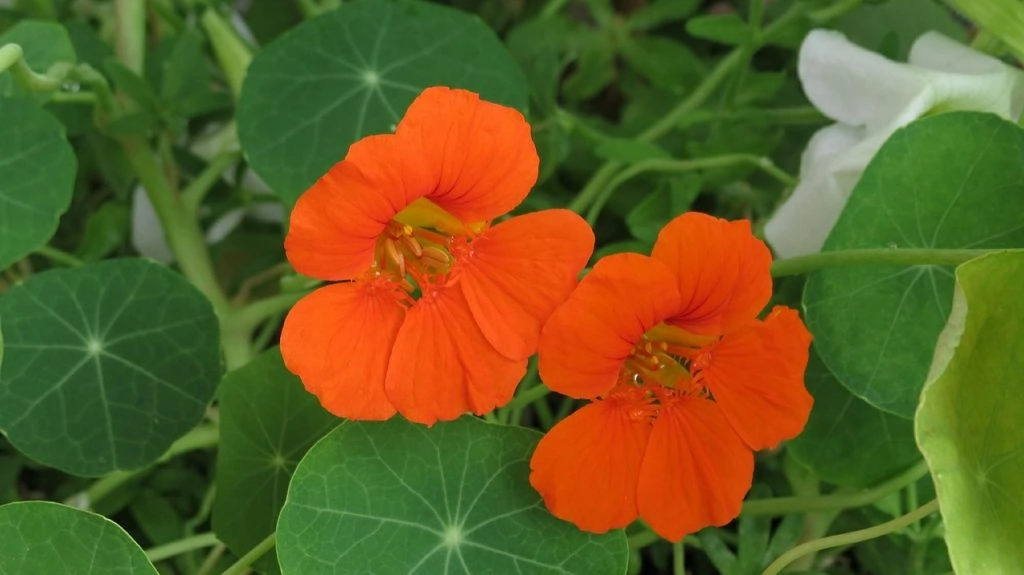
Nasturtiums are trailing edible flowers that are perfect for creating hanging baskets for hummingbirds due to their rich nectar and specially designed deep flowers.
Usually grown as annuals, they come in trailing or bush types. Plant the seeds just after the last frosts outdoors, and they need watering in the growing season and deadheading.
- Common Name: Nasturtiums
- Scientific Name: Tropaeolum
- Growing Zones: 2 – 11
- Sun: Full
- Soil: Well-drained
- Colors: Red, orange, yellow, pink.
- Height: 1 – 10 feet
- Spread: 1 – 3 feet
- Plant Type: Annual
6. Cypress Vine
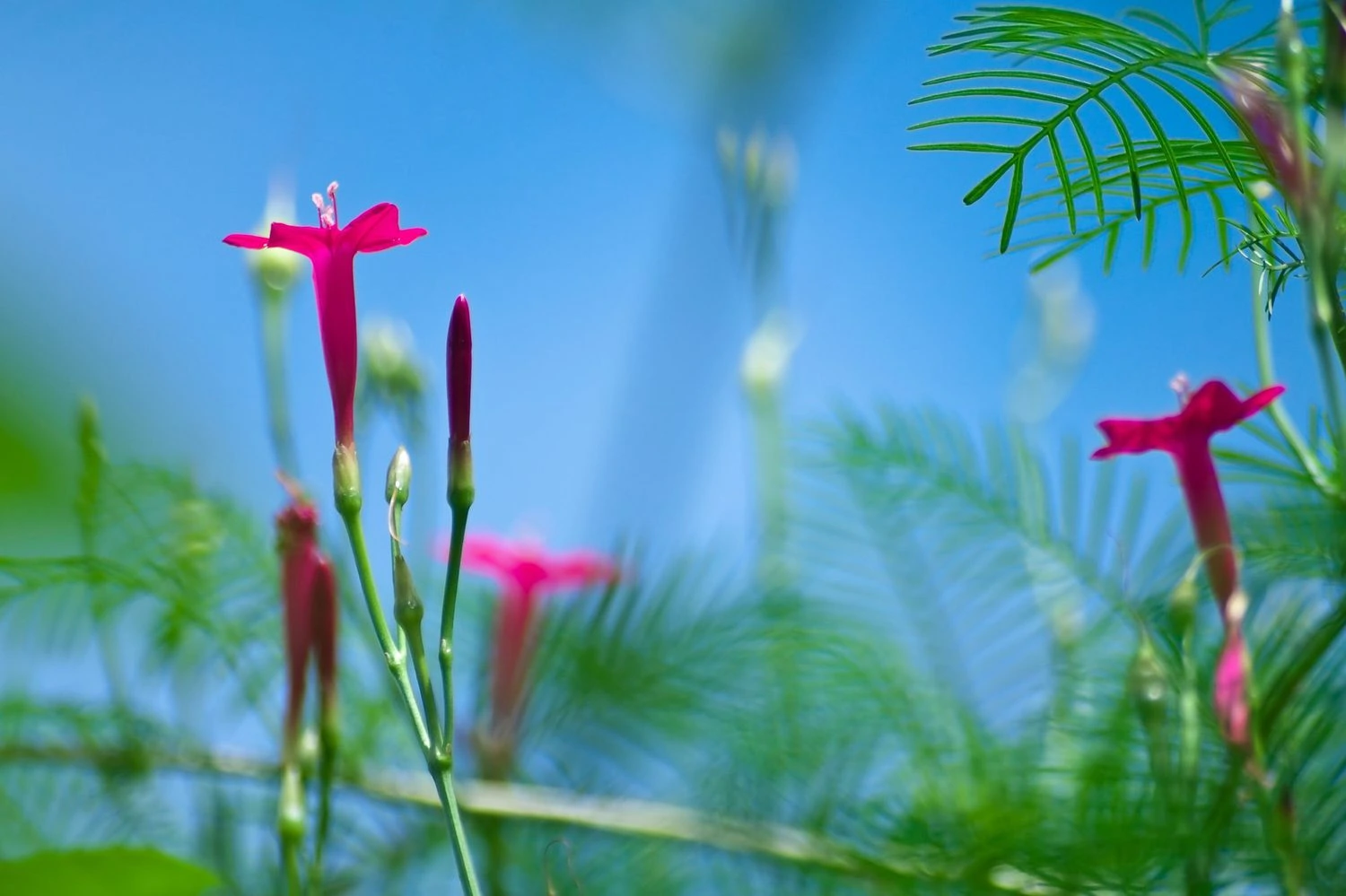
Cypress Vine, Latin name Ipomoea quamoclit, is a member of the bindweed Convolvulaceae family whose origins include tropical South America. It has since been naturalized in other parts of the world, particularly in tropical areas.
The Cypress Vine is cultivated as an ornamental plant that can be a perennial in the tropics but is grown as an annual vine in wintery regions. It looks like a delicate plant with its dainty flowers and fragile-looking leaves, but it is considered an invasive species in some states because it grows fast and can overcrowd other plants and overwhelm nearby structures. Ensure you cut back the plant every year and stop the plant from seeding.
Despite that, it is still one of the best vines for attracting hummingbirds. The Cypress Vine is also called the “Star of Bethlehem” because its flowers are shaped like a star and are also referred to as “hummingbird vine” because their bright red, trumpet-like, nectar-rich flowers are a magnet for hummingbirds.
The red flowers shine beautifully against the Cypress Vine’s thin, thread-like leaves. They grow and spread by twining themselves around structures like arbors, pergolas, chain-link fences, and deck posts that face the sun.
You have to be mindful when growing Cypress Vines because they may overtake other plants when you’re not looking. Instead of moving up, they may grow out, particularly if they latch on to nearby plants.
The trick is to prune them or direct them where you want them to go by carefully wrapping the stems around the support. They do, however, break easily if they lose their support structure.
Another danger to look out for is that all parts of this plant, especially the seeds, are poisonous if eaten by people and pets.
- Common Name: Cypress Vine
- Scientific Name: Ipomoea quamoclit
- Growing Zones: 6 – 11
- Sun: Full sun
- Soil: Fertile, well-drained, and kept evenly moist
- Colors: white, pink, red
- Height: 3 – 20 feet tall
- Spread: climbs to 20 feet
- Plant Type: Perennial vine in tropics, Annual vine in temperate regions
7. Mandevilla
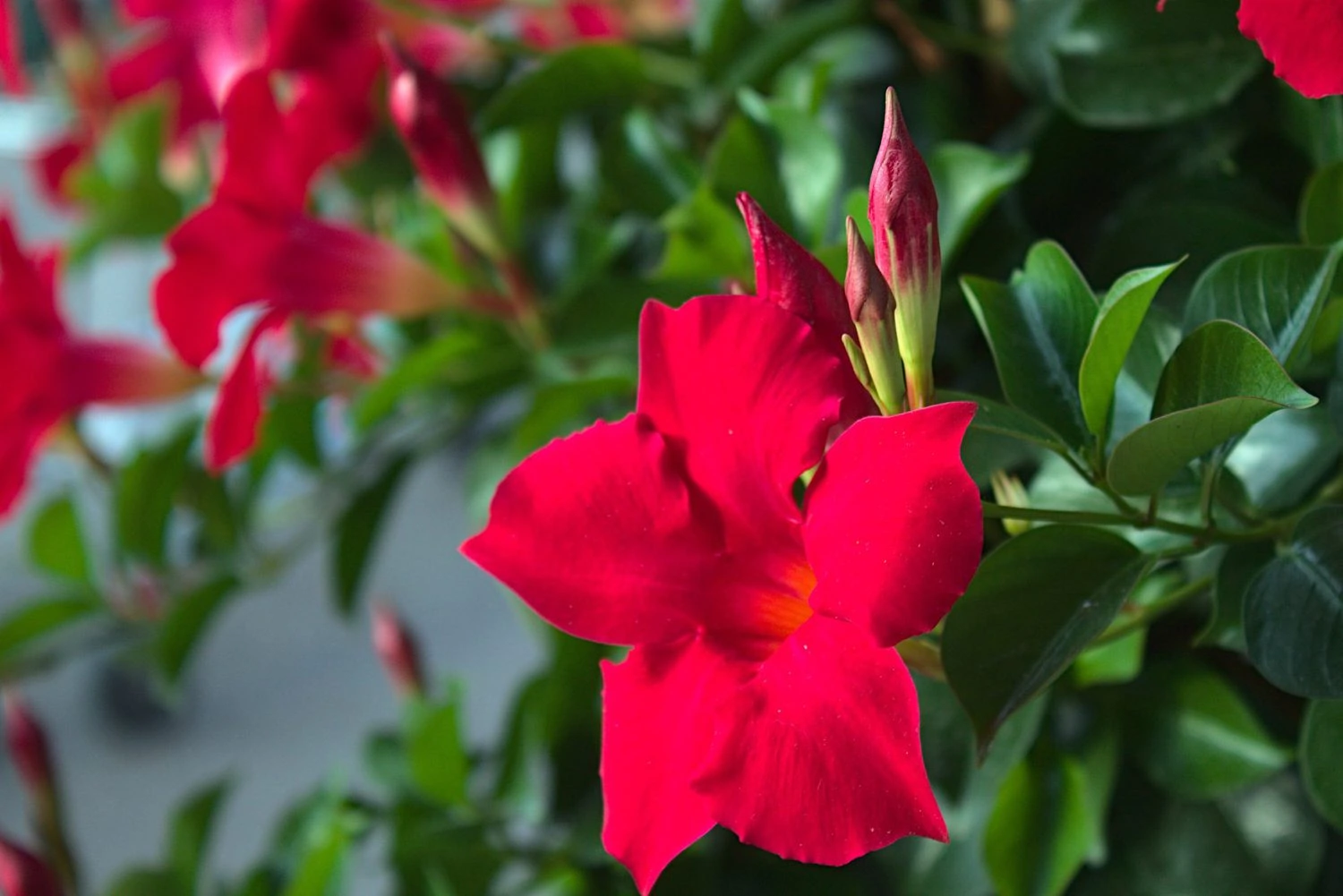
Mandevilla is a group of tropical and subtropical flowering vines from the family Apocynaceae. Mandevilla is also referred to as rocktrumpet, dogbane, or dipladenia, and these plants are native to South America, southwestern United States, and Mexico.
There are many species of Mandevilla, and most of them are climbers with large, showy, fragrant flowers that bloom between late spring to late summer, even up to fall if the weather is mild.
They may have white, pink, and red flowers that look great against fences, trellises, and arbors. The tube-shaped structure of the flowers, plus their bright colors, make them attractive to hummingbirds and other pollinators.
Mandevilla can be grown in pots on the ground or in hanging gardens. They may also be planted directly onto soil with a support structure for them to climb and twine around. They prefer full sunlight, moist soil unless the climate has turned colder, where you have to water them less to keep their roots from rotting.
Another thing to do with Mandevilla to keep them growing and flowering is to re-pot them every year. A good change of soil and pot to accommodate for new growth is essential to keeping Mandevilla healthy. Just be mindful during the process, as Mandevilla is considered toxic. Their milky sap can irritate the skin upon contact, and while they’re not totally poisonous, pets may have a reaction when they ingest any part of the plant.
- Common Name: Mandevilla, rocktrumpet, dogbane or dipladenia
- Scientific Name: Mandevilla
- Growing Zones: 9 – 11
- Sun: Full Sun, partial shade
- Soil: Moist but well-drained
- Colors: white, pink, red
- Height: 3 – 10 feet tall
- Spread: 3 – 4 feet wide
- Plant Type: Perennial vine, an annual vine in colder climates
8. Petunias
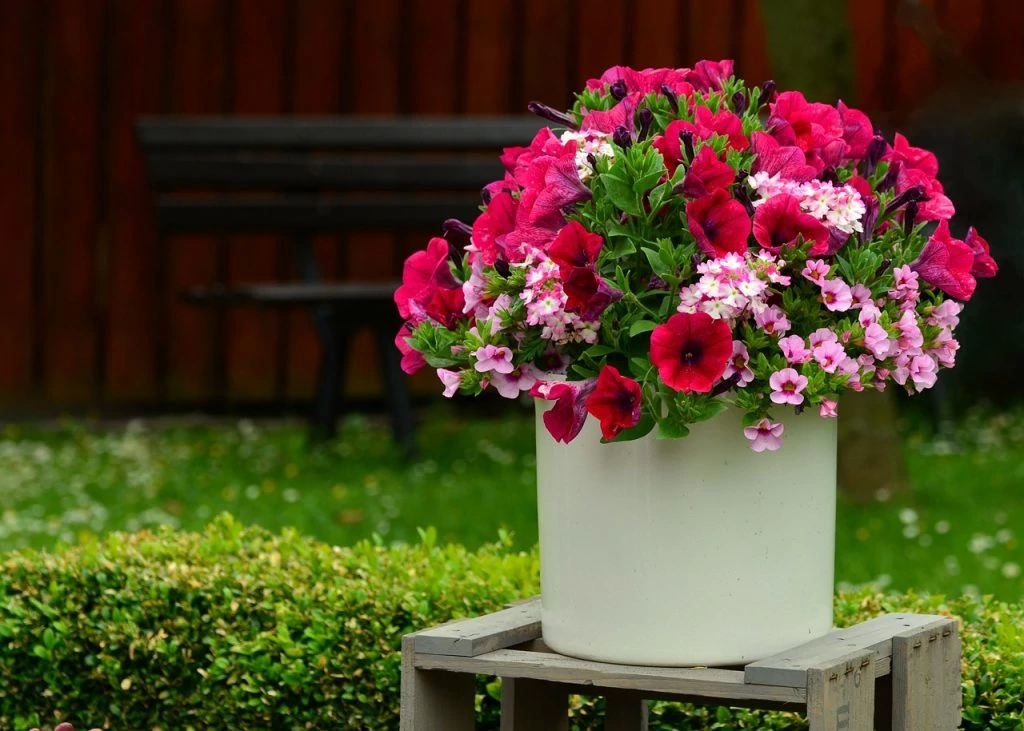
These colorful and inexpensive annuals are easy to grow in a sunny location, and they work great in a container. They create abundant flowers that look great tumbling out of pots and containers.
They are often sold as young plants in flats at a nursery, but you can also grow them from seed. If growing from seed, grow them ten weeks before your last frost date and then plant out once this risk has passed.
Petunias are quite heat-tolerant, but they should get a good soaking about once a week. Prune them to about half the height to prevent them from getting thin and leggy.
Try planting the brighter colors in the reds and pinks for hummingbirds.
- Common Name: Petunias
- Scientific Name: Petunias
- Growing Zones: 9 to 11
- Sun: Full Sun
- Soil: Well-drained moist soil
- Colors: Red, pink, white, blue, purple
- Height: 6 – 18 inches
- Spread: 18 inches to 4 feet
- Plant Type: Tender Perennial, Annual
9. Canary Creeper
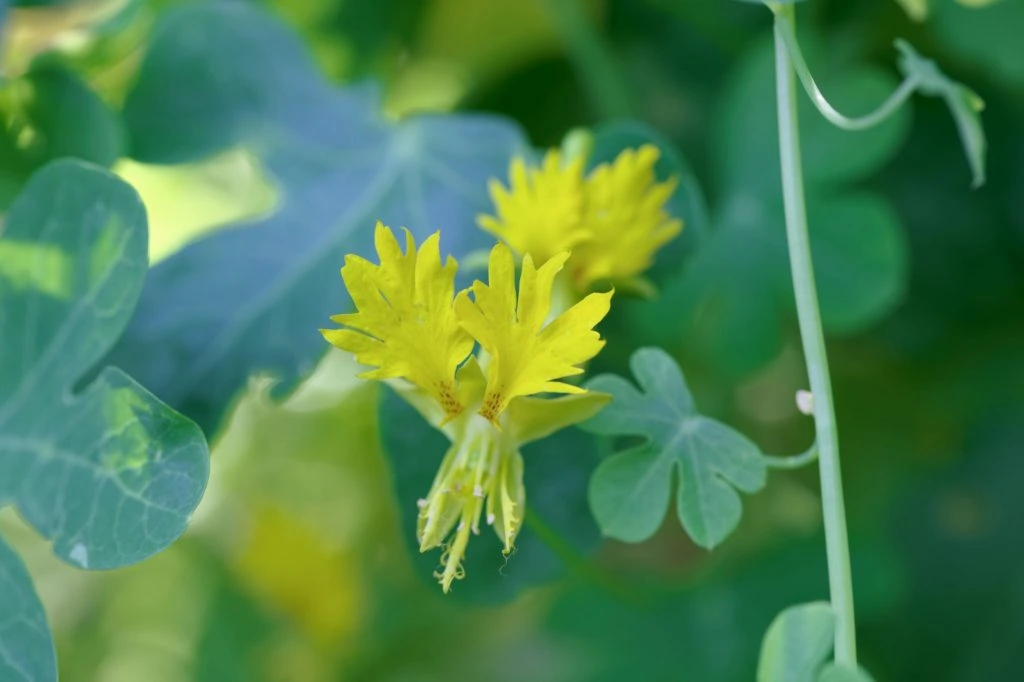
The Canary Creeper, Latin name Tropaeolum peregrinum, is a flowering vine native to Peru and Ecuador from the family of Nasturtiums. Hence it is also referred to as Canary nasturtium. It is grown as an annual ornamental plant because it is frost-tender, particularly in temperate regions.
While its name may indicate that it’s a slow-moving or slow-growing plant, it is the exact opposite. When given full sunlight, the Canary Creeper can grow up to 12 feet in length in just a year.
Another interesting thing about the Canary Creeper, which makes it one of the best vines for hummingbirds, is its flowers. They’re unique because they have two big, yellow, upper fringed petals that are like canary’s wings (hence the name) and three smaller, lower, spurred petals below. The base of the petals has reddish spots. Their leaves are also pretty – small, green, and 5-lobed like fingers on a hand.
These Canary Creeper flowers bloom in mid-summer and last until fall, as long as they’re getting their required full sunlight and adequate water. If you provide them with a trellis or arbor, they will easily climb it. They also grow well in hanging baskets. You may also plant them near other plants without the fear of killing them off, as with other climbing vines.
- Common Name: Canary Creeper, Canarybird Flower, Canarybird Vine, or Canary Nasturtium
- Scientific Name: Tropaeolum peregrinum
- Growing Zones: 10 – 11
- Sun: Full sun
- Soil: Moist but well-drained
- Colors: Yellow
- Height: 10 – 12 feet tall
- Spread:1 – 2 feet wide
- Plant Type: tender perennial, annual
10. Cleome
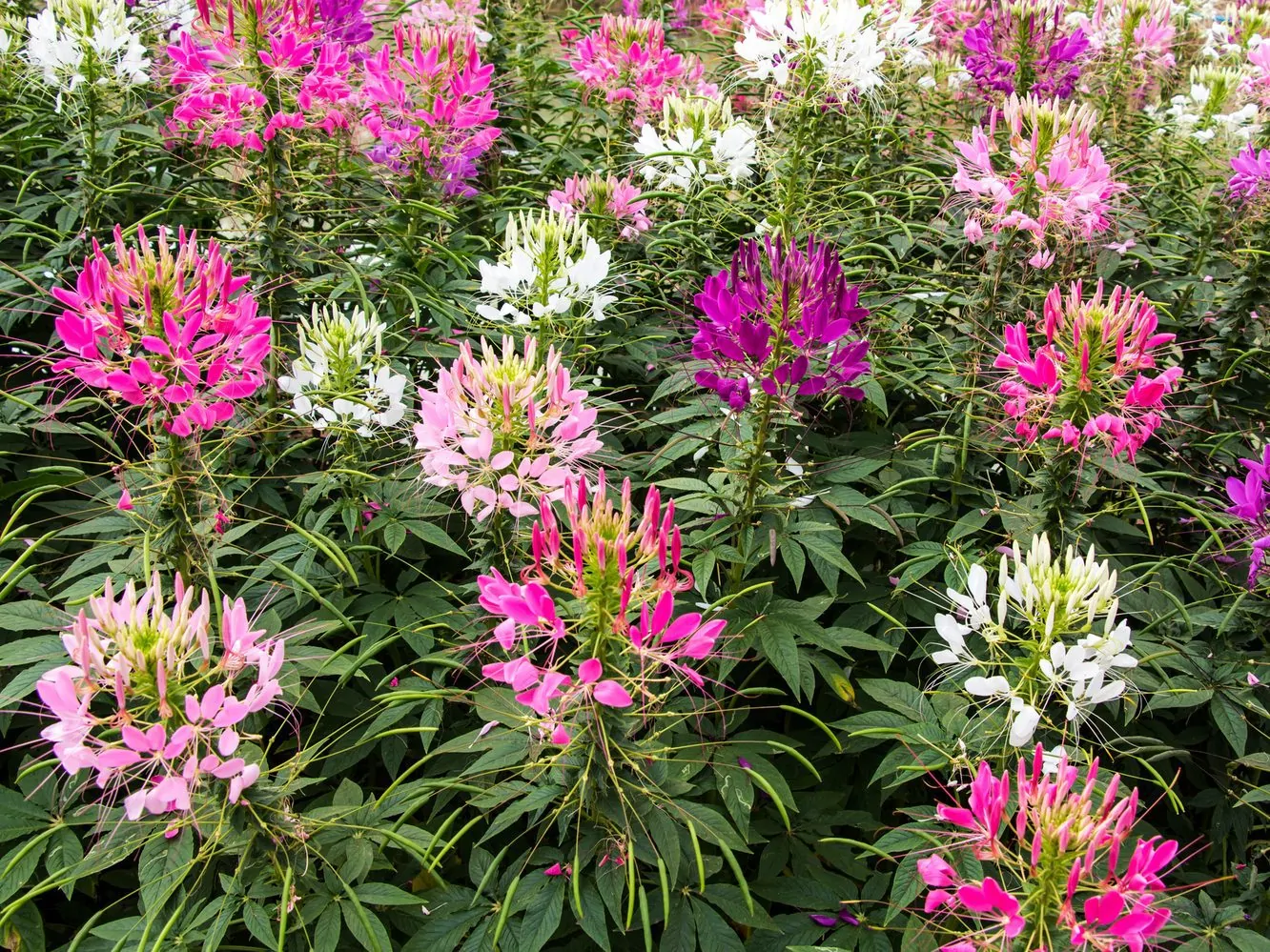
Cleomes, commonly known as spider flowers or spider plants, are herbaceous annual or perennial plants, depending on the climate where they’re grown. They are called spider flowers because their blossoms have stamens that look like multiple “spidery legs”.
With many different varieties, you can find cleomes that are suited to your backyard. For instance, there are cleomes that have thorns, and some don’t. Some grow tall, as much as five feet, while some reach only 2 feet.
What they have in common is the pink, purple and white flowers, some with or without any scent, that are attractive to hummingbirds and bees.
It’s not hard to take care of cleomes. All you need is well-drained soil and to let them have full sunlight. Watering may be done sparingly, especially when the plants are already established.
Cleomes bloom from early summer until frost. Dead flowers will simply disappear to make way for the thin green seedpods. When they ripen, they turn brown and disperse the seeds. You can leave them to self-seed if you want, or you can keep the seeds and use them to plant Cleomes in other parts of your backyard.
- Common Name: Cleomes, spider flower, Rocky Mountain bee plant, stinking clover
- Scientific Name: Cleome, from the Cleomaceae family
- Growing Zones: 10 – 11
- Sun: Full sun, partial sun
- Soil: Average, well-drained
- Colors: white, pink, rose, lavender
- Height: 1.5 – 5 feet tall
- Spread: 1 to 2 feet wide
- Plant Type: Annual
11. Flowering Tobacco
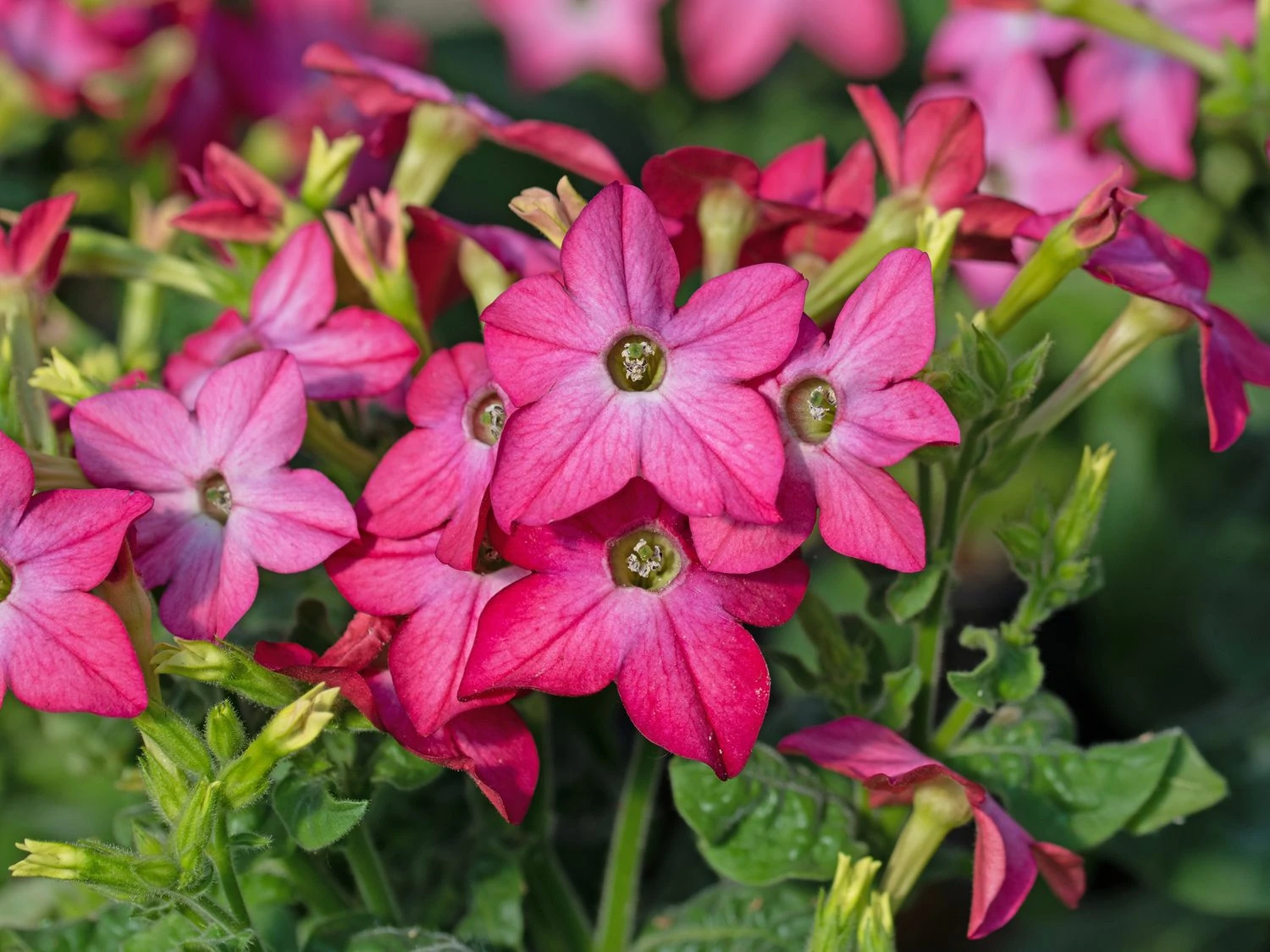
Flowering tobacco plants belong to the family Nicotiana, a group of herbaceous tobacco plants. They are relatives of the true tobacco plants, are usually grown as ornamental plants, and come in different varieties.
If you want fragrant flowering tobacco plants in your garden, you may opt for Nicotania sylvestris or Nicotiana alata, two of the more common and popular varieties. They emit a jasmine fragrance every evening.
Nicotiana sylvestris have wide, oblong leaves and in the center of it rises a central flower spike that can grow several feet tall. There are many tubular, pendant, white, or cream flowers that bloom from June until the first frost. Nicotiana alata plants are also tubular, but they bloom from tall, graceful stems. Their flowers are white and star-shaped and emit sweet perfume at night.
These types of flowering tobacco are easy to plant and grow, requiring full sun or part shade and well-draining soil. What’s more, they’re a great attraction for hummingbirds with their tube-like flowers and fragrance.
However, they may be short-lived since they’re considered annual plants. But, they’re self-seeding, so you can continue to enjoy them for the following year. Just make sure to protect them from the cold and extreme heat.
- Common Name: Flowering tobacco, Jasmine tobacco
- Scientific Name: Nicotiana family
- Growing Zones: 10 – 11
- Sun: Full sun to part shade
- Soil: organically-rich, moist, well-draining
- Colors: white, yellow, pink, red, yellow-green, purple
- Height: 6 to 12 inches, 1 to 3 feet, 3 to 8 feet, 8 to 20 feet tall
- Spread:6 inches to 10 feet, depending on the variety
- Plant Type: Annual
12. Morning Glory
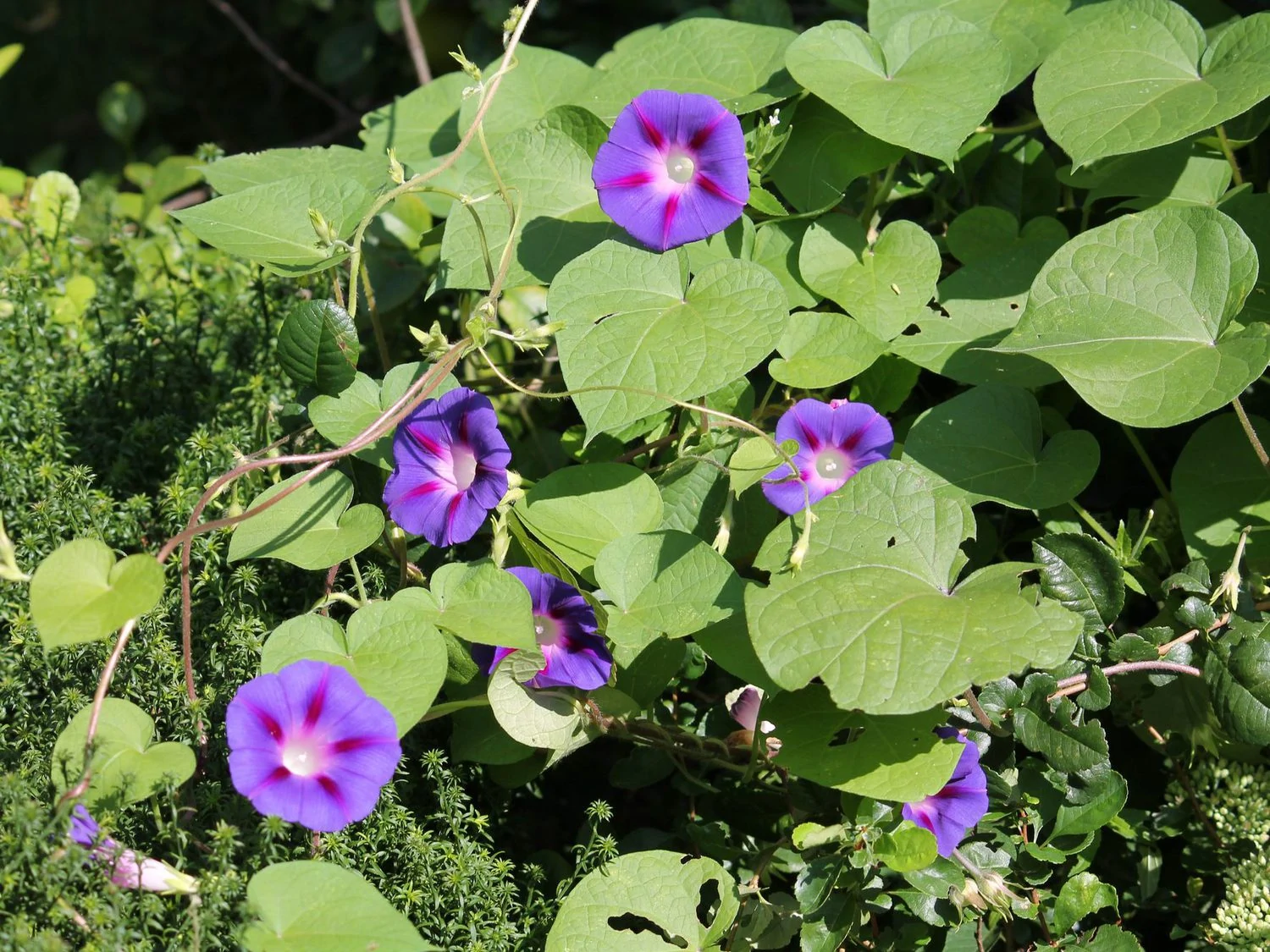
The term “Morning Glory” is the catchphrase for over 1,000 species of flowering plants from the Convolvulaceae. They are referred to as Morning Glory because the flowers open up early in the morning and close up in the heat of the day. However, there are some species that belong to the Morning Glory family that bloom at night instead of the day, like Ipomoea alba.
Morning glory flowers are characterized by bright and colorful blooms, fast-growing vines, bright green foliage, and tolerance for poor and dry soils. They are often twined around arbors or allowed to crawl along the house’s exterior walls with a trellis.
One of the popular Morning Glory species that is known to attract hummingbirds is Ipomoea purpurea. It has bright purple, trumpet-shaped flowers and heart-shaped leaves that open in the morning and close in the afternoon. They bloom from early summer to early fall.
Morning glory is an annual vine but may be considered a perennial in milder climates. It is important to expose Morning Glories to full sun, at most 8 hours of sunlight daily, to get them to fully bloom.
Morning glories may end up being an invasive species if you don’t take care of the fast-growing vines. Its seeds are also toxic if eaten, so children and pets shouldn’t be allowed to get near the plant.
- Common Name: Morning Glory, common morning glory
- Scientific Name: Convolvulaceae family
- Growing Zones: 2 – 11
- Sun: Full sun
- Soil: Moist, well-draining
- Colors: white, pink, purple, blue
- Height: 6 – 10 feet tall
- Spread: 3 – 6 feet wide
- Plant Type: Annual
13. Zinnia
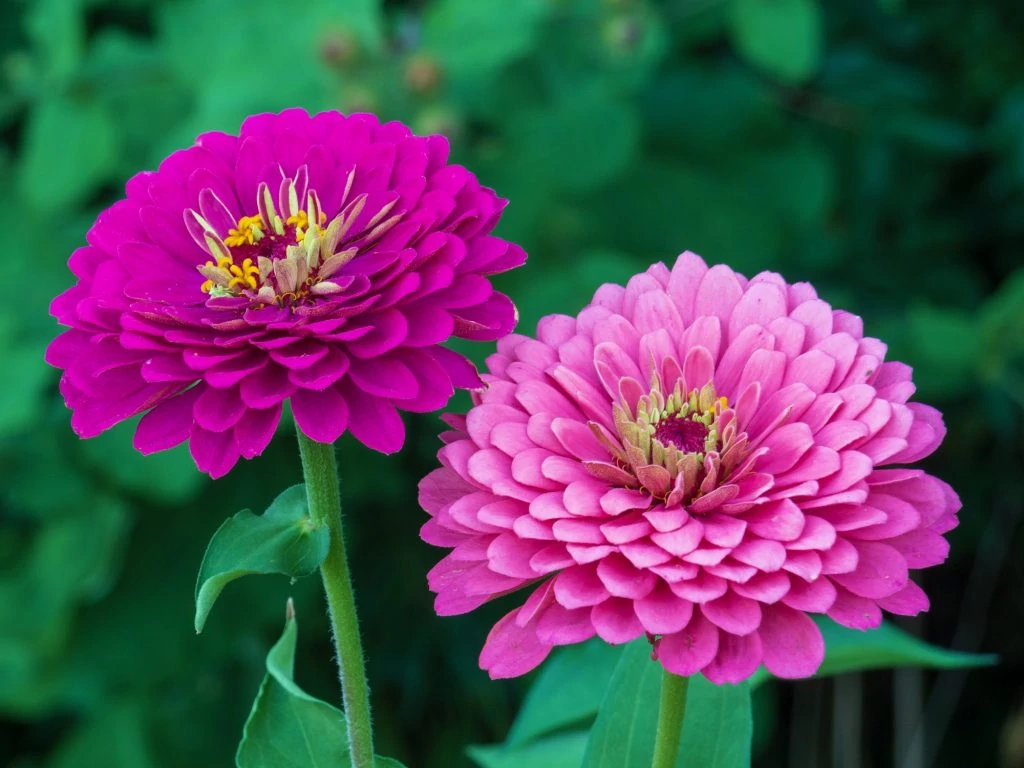
Zinnias are flowering shrubs native to the scrub and dry grasslands of North America. They belong to the genus Heliantheae or the sunflower tribe and to the much larger daisy family, Asteraceae.
There are three main types of zinnias based on the kind of petals that they have. Single-flowered zinnias have a single row of petals with a visible center. Double-flowered zinnias have numerous rows of petals with no visible center. Semi-double-flowered zinnias have numerous rows and visible centers.
The Zinnia elegans, with its tall stems and bright colors, is considered a classic and is most popular for backyards and gardens. It reaches 4 feet tall, has many brilliantly-colored flowers, has a long blooming period from early summer to frost, and attracts pollinators like butterflies and hummingbirds.
Growing zinnias is easy, but you have to plant them directly where you want them because they don’t like being transplanted. But once they become established under full sun and well-draining soil, you will be able to enjoy their bright blooms for a long time.
- Common Name: Zinnea, Zinnia
- Scientific Name: Zinnia elegans
- Growing Zones: Annuals in 2-8, Perennials in 9-11
- Sun: Full sun
- Soil: neutral to slightly alkaline, well-draining
- Colors: white, yellow, orange, pink, red, purple
- Height: 1 – 4 feet tall
- Spread:12 – 18 feet wide
- Plant Type: Annual, Perennial Shrubs

